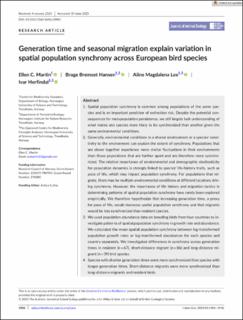| dc.contributor.author | Martin, Ellen Claire | |
| dc.contributor.author | Hansen, Brage Bremset | |
| dc.contributor.author | Lee, Aline Magdalena | |
| dc.contributor.author | Herfindal, Ivar | |
| dc.date.accessioned | 2023-12-04T12:46:23Z | |
| dc.date.available | 2023-12-04T12:46:23Z | |
| dc.date.created | 2023-07-17T18:55:11Z | |
| dc.date.issued | 2023 | |
| dc.identifier.issn | 0021-8790 | |
| dc.identifier.uri | https://hdl.handle.net/11250/3105819 | |
| dc.description.abstract | Spatial population synchrony is common among populations of the same species and is an important predictor of extinction risk. Despite the potential consequences for metapopulation persistence, we still largely lack understanding of what makes one species more likely to be synchronized than another given the same environmental conditions.
Generally, environmental conditions in a shared environment or a species' sensitivity to the environment can explain the extent of synchrony. Populations that are closer together experience more similar fluctuations in their environments than those populations that are further apart and are therefore more synchronized. The relative importance of environmental and demographic stochasticity for population dynamics is strongly linked to species' life-history traits, such as pace of life, which may impact population synchrony. For populations that migrate, there may be multiple environmental conditions at different locations driving synchrony. However, the importance of life history and migration tactics in determining patterns of spatial population synchrony have rarely been explored empirically. We therefore hypothesize that increasing generation time, a proxy for pace of life, would decrease spatial population synchrony and that migrants would be less synchronized than resident species.
We used population abundance data on breeding birds from four countries to investigate patterns of spatial population synchrony in growth rate and abundance. We calculated the mean spatial population synchrony between log-transformed population growth rates or log-transformed abundances for each species and country separately. We investigated differences in synchrony across generation times in resident (n = 67), short-distance migrant (n = 86) and long-distance migrant (n = 39) bird species.
Species with shorter generation times were more synchronized than species with longer generation times. Short-distance migrants were more synchronized than long-distance migrants and resident birds.
Our results provide novel empirical links between spatial population synchrony and species traits known to be of key importance for population dynamics, generation time and migration tactics. We show how these different mechanisms can be combined to understand species-specific causes of spatial population synchrony. Understanding these specific drivers of spatial population synchrony is important in the face of increasingly severe threats to biodiversity and could be key for successful future conservation outcomes. | en_US |
| dc.language.iso | eng | en_US |
| dc.publisher | John Wiley & Sons Ltd on behalf of British Ecological Society. | en_US |
| dc.rights | Navngivelse 4.0 Internasjonal | * |
| dc.rights.uri | http://creativecommons.org/licenses/by/4.0/deed.no | * |
| dc.title | Generation time and seasonal migration explain variation in spatial population synchrony across European bird species | en_US |
| dc.title.alternative | Generation time and seasonal migration explain variation in spatial population synchrony across European bird species | en_US |
| dc.type | Peer reviewed | en_US |
| dc.type | Journal article | en_US |
| dc.description.version | publishedVersion | en_US |
| dc.source.pagenumber | 1904-1918 | en_US |
| dc.source.volume | 92 | en_US |
| dc.source.journal | Journal of Animal Ecology | en_US |
| dc.source.issue | 9 | en_US |
| dc.identifier.doi | 10.1111/1365-2656.13983 | |
| dc.identifier.cristin | 2162605 | |
| cristin.ispublished | true | |
| cristin.fulltext | original | |
| cristin.qualitycode | 2 | |

